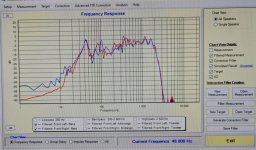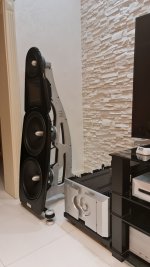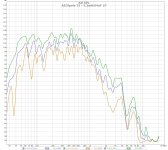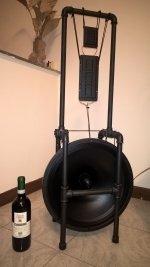The point I was making is the tweeter is offset from the vertical line of the mid/woofer, this will cause both vertical and horizontal lobing. Lining the tweeter with the vertical axis of the woofer removes the vertical lobes. This then has the effect of having the off axis response of the speaker uniform both sides giving a better power response. Lookup Linkwitz site for the importance inroom power repsponse.I bring the tweeters in so high all they provide is a bit of cymbal shimmer.
I use Tom Chr Modulus86 amplifiers x4 to power my current OB's and I have just bought his Mod286 to power the subwoofers in my upcoming LXmini+2 build.Interesting. What type of SET do you use?
Mine is an active system, also OB, where the bottom is driven by class-D, the tweeter from a 45-type SET above 1.7kHz, and at some point wondered about DX3 for midrange driven by SET. DX3 is often used with SET but hadn't seen it in OB with SET.
Thank you.
These are brilliant amplifiers and out perform amps costing $1000's. There have very low THD and IMD so they are very transparent.
The point I was making is the tweeter is offset from the vertical line of the mid/woofer, this will cause both vertical and horizontal lobing. Lining the tweeter with the vertical axis of the woofer removes the vertical lobes. This then has the effect of having the off axis response of the speaker uniform both sides giving a better power response. Lookup Linkwitz site for the importance inroom power repsponse.
I've tried it both ways and the difference if any is inaudible to my ears. If you offset the full range driver ( as MJK recommends ) the extra room makes sense for a tweeter location.
Last edited:
The point I was making is the tweeter is offset from the vertical line of the mid/woofer, this will cause both vertical and horizontal lobing. Lining the tweeter with the vertical axis of the woofer removes the vertical lobes. This then has the effect of having the off axis response of the speaker uniform both sides giving a better power response. Lookup Linkwitz site for the importance inroom power repsponse.
Lining the tweeter with the vertical axis of the woofer removes the horizontal lobes.
Simulations are nice to tell driver location on baffle effect. However in farfield those errors are very difficult to hear, because we hear the sum of off-axis sound (listening window) and reflections.
Same goes pretty much for vertical c-c lobing effect, unless it is very bad.
No it removes the vertical lobes. I don't use simulation I use actual measurements on and off axis. With the tweeter off center the off axis left to right response will differ. It's well known speakers that have similar off axis and on axis response will sound better. Floyd Toole did a lot of this research with Harmon.Lining the tweeter with the vertical axis of the woofer removes the horizontal lobes.
Simulations are nice to tell driver location on baffle effect. However in farfield those errors are very difficult to hear, because we hear the sum of off-axis sound (listening window) and reflections.
Same goes pretty much for vertical c-c lobing effect, unless it is very bad.
https://www.stereophile.com/content/blind-listening-harman-international
Um, not really, but I think you and him are saying the same thing anyway. Eliminating the horizontal offset makes the horizontal polar response more uniform (vs offset tweeter)... that's what you meant, right?No it removes the vertical lobes.
I'm new to OB design, but a novice to speaker diy in general. I've been discussing this type of hybrid design with my wife. I visited a local shop where a job design was setup. The first 20 seconds of music was fantastic and we were so eager to hear the full track until the drums were introduced and that's when the system collapsed... sonically that is. Flabby bass, dominant midrange, but super clear treble! To say the least we were disappointed. This experience occurred over a year ago, but the thought of how satisfying the midrange and treble just appeared in the room was very promising as a starting point to a great system if only to get bass out of the OB design! Your approach I can would fill this void. Best of both world designs. I'll be watching your progress.Here is a project I'm working on, called the BaSSlines. First is what it will look like when complete, with Lexan and laminated hardwood baffle. Second is the prototype out of mdf. Just the mid is open baffle.
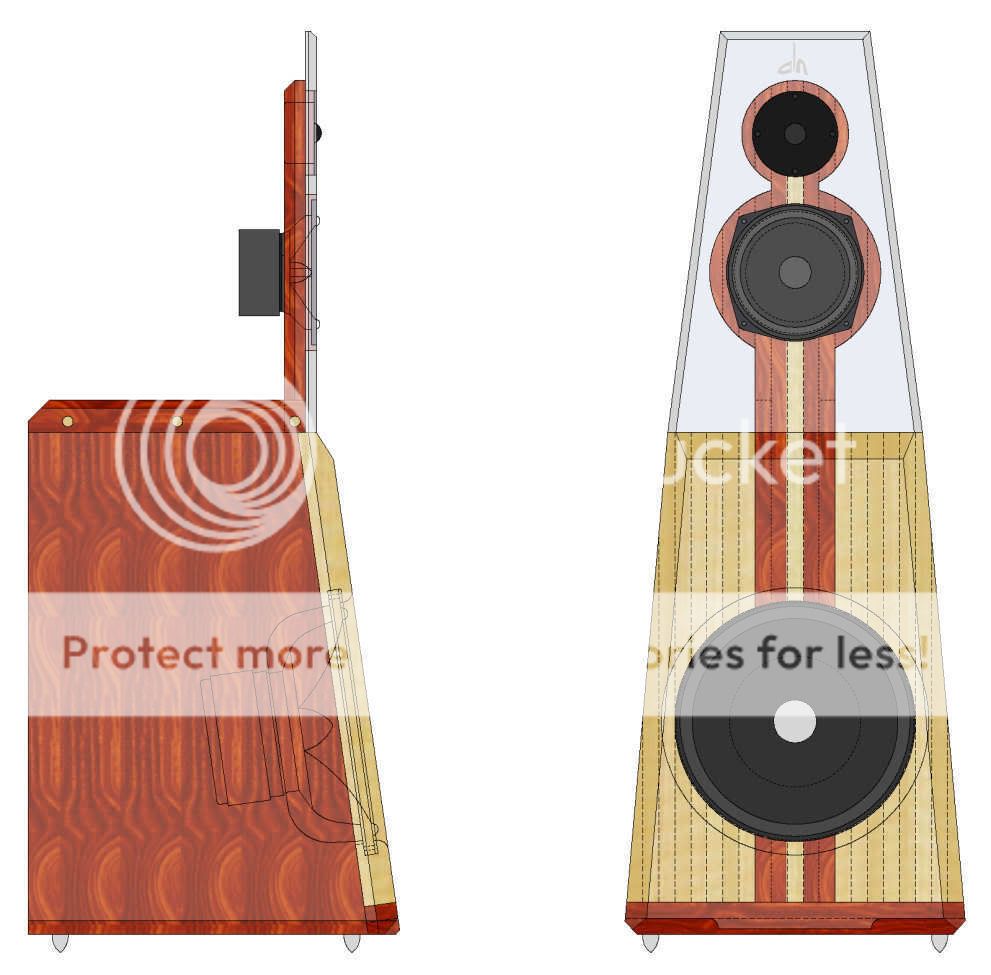
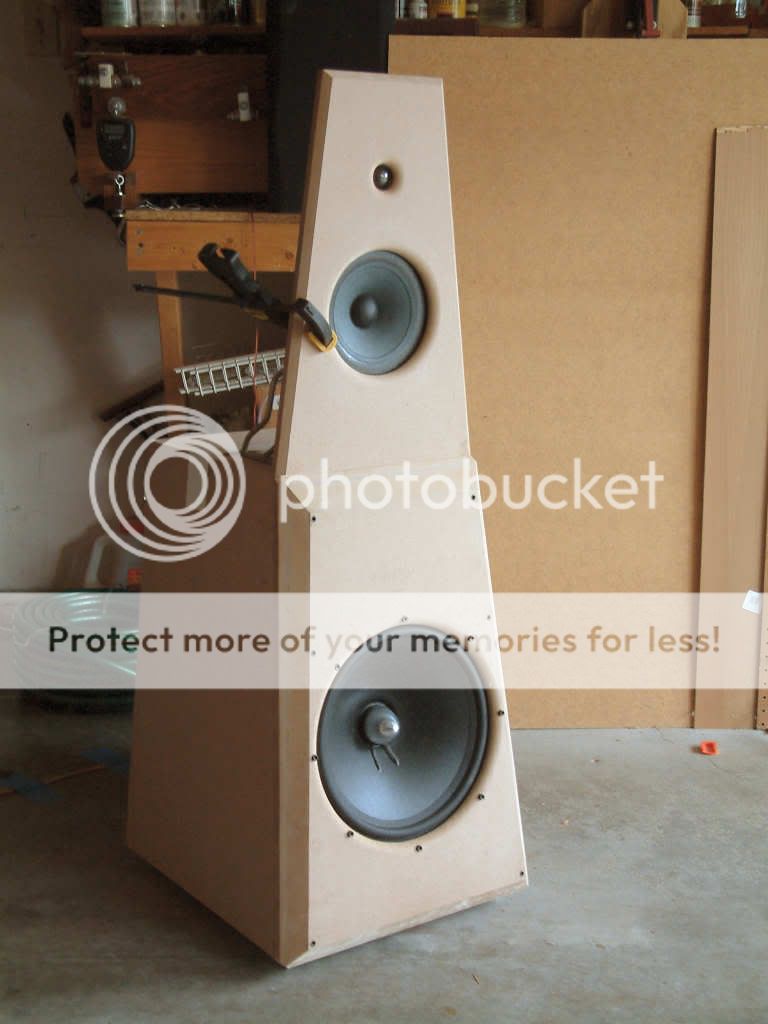
OB speakers can be fantastic, even average OB's are pretty good. The secret is to match the drivers so their polar response is even and they can output enough SPL an smooth enough respone to not reuire too much high Q equalization.
So ideally use the smallest diameter driver with larger excursion.
Open baffle bass works differently that seal box as the OB does not excite room modes as much as seal subs. It just needs to be implemented correctly.
So ideally use the smallest diameter driver with larger excursion.
Open baffle bass works differently that seal box as the OB does not excite room modes as much as seal subs. It just needs to be implemented correctly.
After a long period of rest, I finally managed to bring home my new Open Baffle project with AEDipole 15 / 16R, TD8M and Beyma TPL200H speakers.
All coils from AEDipole15 are connected in parallel to get 4R. Amplification for them I do with an NCore 400.
I did some measurements (UMIK-1) in Audiolense and as you can see the low frequencies start to drop sharply from 40 Hz.
I'm curious if anyone else did measurements for AE Dipol 15 ,and what the result was.
Thank you very much .
All coils from AEDipole15 are connected in parallel to get 4R. Amplification for them I do with an NCore 400.
I did some measurements (UMIK-1) in Audiolense and as you can see the low frequencies start to drop sharply from 40 Hz.
I'm curious if anyone else did measurements for AE Dipol 15 ,and what the result was.
Thank you very much .
Attachments
Last edited:
I have made a baffless system with one AE Dipole 15 with coil in parallel, b&g neo8 and neo3, passive xover and UCD400 amplification. here are some measures taken with the one woofer at 2m from wall, and at an height of 5cm from the floor, with a 2nd order lowpass filter with 5.2mH and 94uF :After a long period of rest, I finally managed to bring home my new Open Baffle project with AEDipole 15 / 16R, TD8M and Beyma TPL200H speakers.
All coils from AEDipole15 are connected in parallel to get 4R. Amplification for them I do with an NCore 400.
I did some measurements (UMIK-1) in Audiolense and as you can see the low frequencies start to drop sharply from 40 Hz.
I'm curious if anyone else did measurements for AE Dipol 15 ,and what the result was.
Thank you very much .
Attachments
After a long period of rest, I finally managed to bring home my new Open Baffle project with AEDipole 15 / 16R, TD8M and Beyma TPL200H speakers.
All coils from AEDipole15 are connected in parallel to get 4R. Amplification for them I do with an NCore 400.
I did some measurements (UMIK-1) in Audiolense and as you can see the low frequencies start to drop sharply from 40 Hz.
I'm curious if anyone else did measurements for AE Dipol 15 ,and what the result was.
Thank you very much .
Sorry, mine are not AE DIpole 15 but AE LO15...I have made a baffless system with one AE Dipole 15 with coil in parallel, b&g neo8 and neo3, passive xover and UCD400 amplification. here are some measures taken with the one woofer at 2m from wall, and at an height of 5cm from the floor, with a 2nd order lowpass filter with 5.2mH and 94uF :
Thank you , Robi , very much for your answer. In the meantime, I also spoke with John from AE, who confirmed to me what a normal 40 Hz descent is. So, I'm going to think of a subwofer. Otherwise the sound is very nice. I was especially surprised by the TPL200H (no back cover). It is so clear! And it has a very good synergy with TD8M. I cut the frequencies at 250hz-2500 in Audiolense with convolver in Roon.
Glad you are liking your TPL200H open back. Same thing here with TPL-150H open back. I noticed Spatial Audio maintains the felt in the back when using it in dipole, but I like it better without felt. How are you using your 200 OB?Thank you , Robi , very much for your answer. In the meantime, I also spoke with John from AE, who confirmed to me what a normal 40 Hz descent is. So, I'm going to think of a subwofer. Otherwise the sound is very nice. I was especially surprised by the TPL200H (no back cover). It is so clear! And it has a very good synergy with TD8M. I cut the frequencies at 250hz-2500 in Audiolense with convolver in Roon.
I don't have a mid bass like yours, so I have put the AE to the limit, up to 1Khz an more... and they are very very good in the mid range. I can't imagine yours TD8M!Thank you , Robi , very much for your answer. In the meantime, I also spoke with John from AE, who confirmed to me what a normal 40 Hz descent is. So, I'm going to think of a subwofer. Otherwise the sound is very nice. I was especially surprised by the TPL200H (no back cover). It is so clear! And it has a very good synergy with TD8M. I cut the frequencies at 250hz-2500 in Audiolense with convolver in Roon.
I initially wanted to go with another 2-way project.
But John from AE advised me not to go with Dipole above 350 Hz. That's why I went for the TD8M and I'm not sorry I took it.
A good thing happened two nights ago I wanted to get to the back wires and pulled the speakers even further from the back wall. (I mean at about 1.5m) I can't tell you, what a beautiful bass appeared. I didn't make measurements, but it certainly became lower. Now the bass is present, I feel a light fist on my chest at a reasonable volume.
I wanted to get to the back wires and pulled the speakers even further from the back wall. (I mean at about 1.5m) I can't tell you, what a beautiful bass appeared. I didn't make measurements, but it certainly became lower. Now the bass is present, I feel a light fist on my chest at a reasonable volume.
But John from AE advised me not to go with Dipole above 350 Hz. That's why I went for the TD8M and I'm not sorry I took it.
A good thing happened two nights ago
Hi
These are my latest no baffle speakers with an 18" H-baffle sub. The Sub is actually the table in the back.
View attachment 1008593
View attachment 1008583
All the important intellectual work was done by other people, where I especially have to thank Charlie Laub for introducing the idea of the Dayton Audio wave guided tweeter back to back. This is a very elegant solution for constant directivity in the treble region. I like it better than the cheap GRS planar I tried before. That one measures and sounds worse, at least to my ears.
The higher midrange driver is a Satori 6,5" woofer and the lower midrange a Faital 400Pro.
The sub is a sb audience bianco 18" woofer.
My listening distance is roughly 2,50 meters and the speakers are ca 1 meter in front of the wall and toed in. The subwoofer is toed in a little as well, that reduces room modes at the listening position a great deal.
The right speaker measures like that in the listening position:
View attachment 1008579
Step Response:
View attachment 1008580
Impulse response:
View attachment 1008581
Spectrogram:
View attachment 1008590 Phase, IR and step response is reworked with rePhase and the resulting IR is inserted in the signal chain via Camilla. (edit: But I am still not sure if this is really an auditory improvement or just different, sometimes it feels as it sounds a little bit artificial)
Directivity is as expected, these are the three drivers on the stand rotated from 0 to 90 degrees, measured a meter away in the room:
View attachment 1008589
It is a very pleasing sounding speaker system now in my ca. 35 square meter, live sounding room. It took me some time to get the crossovers right for my ears, I started out with regular 24dB LR crossovers but ended up with roughly 12 dB asymmetric Bessel at 2100Hz from tweeters to midrange and at 400Hz from mid to low mid. The sub crosses at 100Hz steeper. Crossovers are made with two of those dsps, in that area might be room for improvement, better DA converters than those might make a difference, even though the speakers sound spectacular as is. This is the configuration I am going to live with for a while.
Thanks to everybody who made that project possible and merry christmas
Very cool build!
Your response is very interesting to me. What kind of music do you listen to, and what drove the decision for the big rolloff above ~8K?
I have been prototyping some DML panels that have great response from about 60Hz to 10kHz that then require heavy EQ to cover everything above. I mainly listen to jazz fusion and funk from the 70s so generally nothing too high res. Just wondering if I should ease up on my high frequency requirements. Easiest way to check would obviously be to listen, but to my ear a flatter high end sounds better, even for older music.
Hi Vitalica,Thank you , Robi , very much for your answer. In the meantime, I also spoke with John from AE, who confirmed to me what a normal 40 Hz descent is. So, I'm going to think of a subwofer. Otherwise the sound is very nice. I was especially surprised by the TPL200H (no back cover). It is so clear! And it has a very good synergy with TD8M. I cut the frequencies at 250hz-2500 in Audiolense with convolver in Roon.
doesn't the TD8M already beam too much at 2500Hz?
John from AE told me that the TD8M goes up to 4000hz, but he recommended me to cut it to 2500hz.
That's what I did and I'm very happy with the result and it's a great synergy with the Beyma TPL200. It's the first time in recent years that I really enjoy listening to music
That's what I did and I'm very happy with the result and it's a great synergy with the Beyma TPL200. It's the first time in recent years that I really enjoy listening to music
John from AE told me that the TD8M goes up to 4000hz, but he recommended me to cut it to 2500hz.
That's what I did and I'm very happy with the result and it's a great synergy with the Beyma TPL200. It's the first time in recent years that I really enjoy listening to music
Thanks for your response and Congratulations.
The AEs are definitely fantastic drivers.
Im using the Dipole18 by my own.
I was just asking, because I'm still searching for the right midrange solution in my open baffles (4-way).
Having a good directivity is one of my goals. I will use a similar XO frequency to my Mundorf AMT. But I'm still not sure, which driver size I can chose without compromising the directivity.
Best regards
Matthias
- Home
- Loudspeakers
- Multi-Way
- Ultimate Open Baffle Gallery
